-
Out of stock
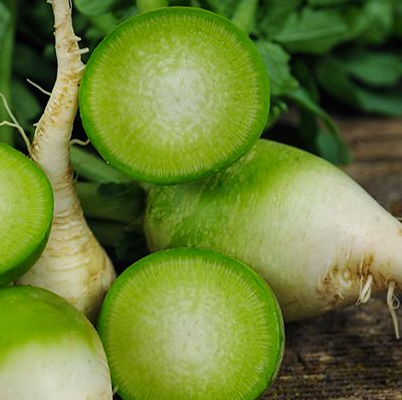 The unmistakably pungent flavor of wasabi can clear the sinuses and invigorate the palate. The energizing flavor found in plants like true wasabi and horseradish root can also be found in the Wasabi Radish of Japan. This is a medium-size oblong Daikon type radish packs a wallop of tingling wasabi heat. Add the peppery flavour to stir-fries and sandwiches or sliced paper-thin to enhance a salad or your favorite Asian recipe. Spring planting benefit is that you can let a couple of plants go to seed as their pods are delicious and pack immense heat. Sow early in spring but late in summer August-September when the soil is 18-22 C produces a great crop. Plenty of water and space helps prevent these delightful hot radishes from going woody.
The unmistakably pungent flavor of wasabi can clear the sinuses and invigorate the palate. The energizing flavor found in plants like true wasabi and horseradish root can also be found in the Wasabi Radish of Japan. This is a medium-size oblong Daikon type radish packs a wallop of tingling wasabi heat. Add the peppery flavour to stir-fries and sandwiches or sliced paper-thin to enhance a salad or your favorite Asian recipe. Spring planting benefit is that you can let a couple of plants go to seed as their pods are delicious and pack immense heat. Sow early in spring but late in summer August-September when the soil is 18-22 C produces a great crop. Plenty of water and space helps prevent these delightful hot radishes from going woody. -
Out of stock
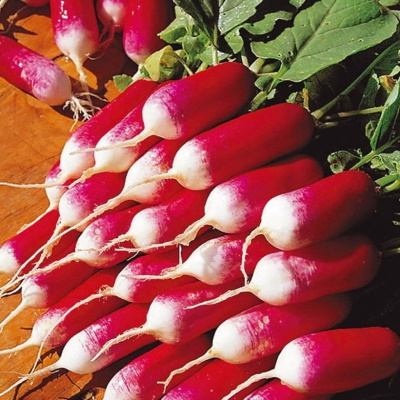 Early variety (18-20 days).Cylindrical, pink roots, weight 25-30g (0.8-1 oz.) with a white tip. White, tender, juicy, flesh without bitterness and a slightly tangy taste. Recommended for open ground and film shelter.
Early variety (18-20 days).Cylindrical, pink roots, weight 25-30g (0.8-1 oz.) with a white tip. White, tender, juicy, flesh without bitterness and a slightly tangy taste. Recommended for open ground and film shelter. -
Out of stock
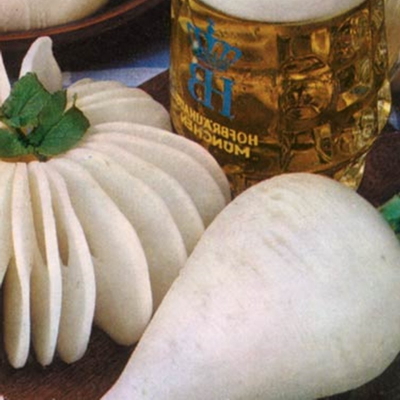
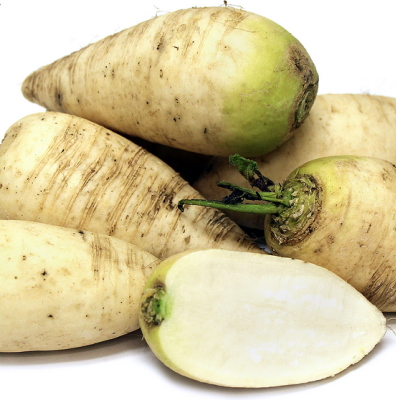 Mid-season variety (80-90 days). Large, oval, white roots, weight 200-500g. Fragrant white, dense, juicy, flesh with a spicy taste. Resistant to cracking. Can be stored up to 3 months. Sow in spring for fresh radishes in summer, sow in summer for winter storage. Pairs perfectly with beer, hence the name.
Mid-season variety (80-90 days). Large, oval, white roots, weight 200-500g. Fragrant white, dense, juicy, flesh with a spicy taste. Resistant to cracking. Can be stored up to 3 months. Sow in spring for fresh radishes in summer, sow in summer for winter storage. Pairs perfectly with beer, hence the name. -
Out of stock
 Antique horticultural treasure from China of unearthly beauty. Large 11-14 cm round roots that are creamy-white outside, with a vivid burst of watermelon-rose colour at the center. The flesh is crispy, mild, and refreshing, with a sweet flavor perfect for salads, garnishes, or even pickling. Enjoy roasted or sautéed with parsnips, carrots, and other fall root vegetables. Best grown in cool weather. Sow in late summer for a fall crop. This is a winter variety radish.
Antique horticultural treasure from China of unearthly beauty. Large 11-14 cm round roots that are creamy-white outside, with a vivid burst of watermelon-rose colour at the center. The flesh is crispy, mild, and refreshing, with a sweet flavor perfect for salads, garnishes, or even pickling. Enjoy roasted or sautéed with parsnips, carrots, and other fall root vegetables. Best grown in cool weather. Sow in late summer for a fall crop. This is a winter variety radish. -
Out of stock
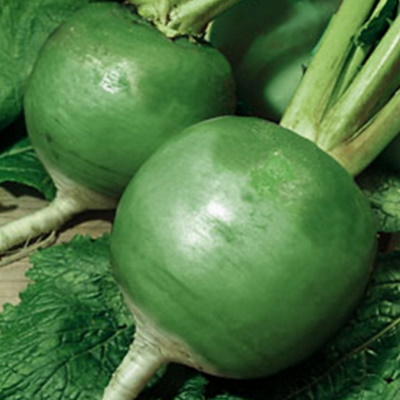 Mid-season variety (65-80 days). Large, smooth, dark green roots, with a white tip, weight 200-500g (7-17 oz.). Light green, juicy flesh with a slightly tangy taste. Sow in spring for summer harvest, sow in July for winter storage.
Mid-season variety (65-80 days). Large, smooth, dark green roots, with a white tip, weight 200-500g (7-17 oz.). Light green, juicy flesh with a slightly tangy taste. Sow in spring for summer harvest, sow in July for winter storage. -
Out of stock
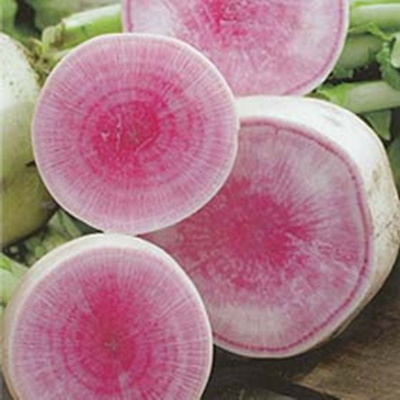 Mid-season (60-90 days) cold-resistant, Chinese winter radish. Green-pink roots with pink-red flesh. Weight 500-1000g (18-36oz.). Excellent for long term storage.
Mid-season (60-90 days) cold-resistant, Chinese winter radish. Green-pink roots with pink-red flesh. Weight 500-1000g (18-36oz.). Excellent for long term storage. -
Out of stock
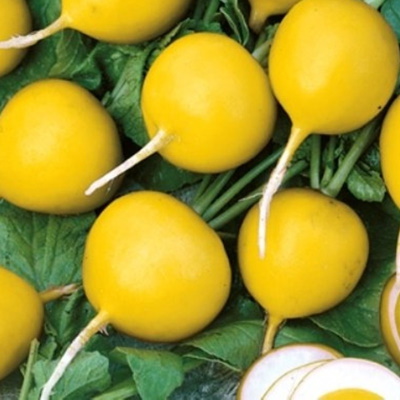 Early (23-28 days from germination) open-pollinated variety. Round, yellow-golden radishes, weight 22-24g (0.7-0.8oz) with an excellent taste. White, tender, juicy, slightly spicy taste. High productivity and uniform radishes. Use fresh.
Early (23-28 days from germination) open-pollinated variety. Round, yellow-golden radishes, weight 22-24g (0.7-0.8oz) with an excellent taste. White, tender, juicy, slightly spicy taste. High productivity and uniform radishes. Use fresh. -
Out of stock
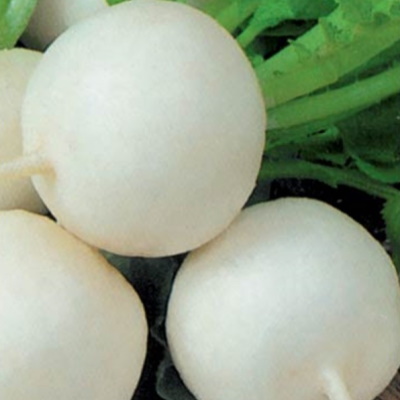 Mid-season variety (30-35 days). Round, white, medium size root, weight 25-30g (0.8-1 oz.). Excellent tasting, white, tender and very juicy flesh. Recommended for open ground as well as for greenhouses.
Mid-season variety (30-35 days). Round, white, medium size root, weight 25-30g (0.8-1 oz.). Excellent tasting, white, tender and very juicy flesh. Recommended for open ground as well as for greenhouses. -
Out of stock
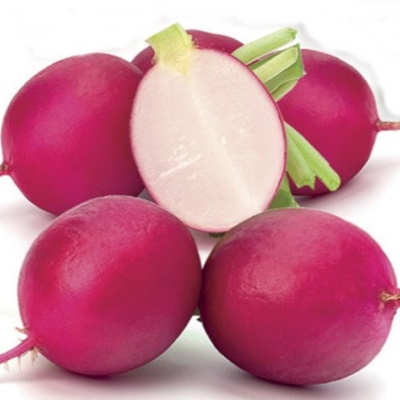 Early (20-25 days) heirloom from Italy. Unique, beautiful, almost egg-shaped, pink radishes. Crunchy, snow-white pulp with an excellent, mild taste.
Early (20-25 days) heirloom from Italy. Unique, beautiful, almost egg-shaped, pink radishes. Crunchy, snow-white pulp with an excellent, mild taste. -
Out of stock
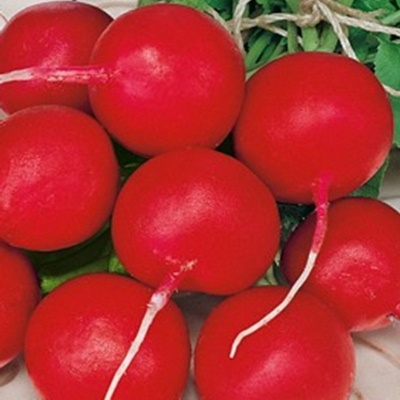 Early (25-28 days) open pollinated Ukrainian variety for open ground and greenhouses. Round, carmine-red radishes. White tender, juicy, crispy flesh with an excellent, slightly sharp taste.
Early (25-28 days) open pollinated Ukrainian variety for open ground and greenhouses. Round, carmine-red radishes. White tender, juicy, crispy flesh with an excellent, slightly sharp taste. -
Out of stock
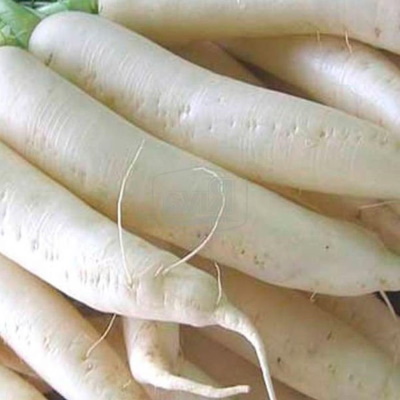 Mid-season variety (50-65 days). Large, wedge-shaped roots, weight 200-230g (7-8 oz.). White, firm, and juicy flesh with a spicy taste. Grow in spring and summer in open ground, early spring, and late fall under film shelter. Use fresh.
Mid-season variety (50-65 days). Large, wedge-shaped roots, weight 200-230g (7-8 oz.). White, firm, and juicy flesh with a spicy taste. Grow in spring and summer in open ground, early spring, and late fall under film shelter. Use fresh. -
Out of stock
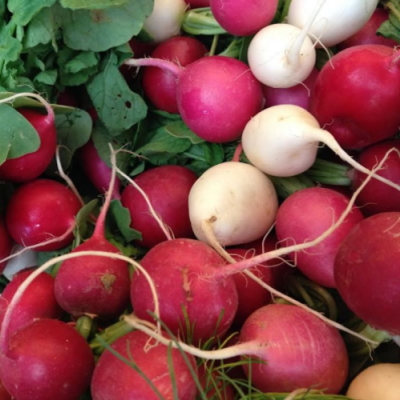 This type of radish can grow as large as a small apple without becoming woody. They require constant even moisture. Easter Egg II radish seeds are a blend of six different coloured radishes. The flesh is crispy and white yet mild, making great snacks for children and adults alike. The colours of the flesh are white, rose pink, bubblegum pink, amethyst, mauve, scarlet and purple roots. The roots are round and grow at a similar rate. Great for both for spring and fall growing. Try our planting method for radishes in groups of 3-4 seeds, pulling out the largest in each group. Sow in spring every 1-2 weeks to have a continual crop in the spring, but save some seed to sow again in late August for fall crops. Don't keep in the ground once they start to get woody or bolt.
This type of radish can grow as large as a small apple without becoming woody. They require constant even moisture. Easter Egg II radish seeds are a blend of six different coloured radishes. The flesh is crispy and white yet mild, making great snacks for children and adults alike. The colours of the flesh are white, rose pink, bubblegum pink, amethyst, mauve, scarlet and purple roots. The roots are round and grow at a similar rate. Great for both for spring and fall growing. Try our planting method for radishes in groups of 3-4 seeds, pulling out the largest in each group. Sow in spring every 1-2 weeks to have a continual crop in the spring, but save some seed to sow again in late August for fall crops. Don't keep in the ground once they start to get woody or bolt.
